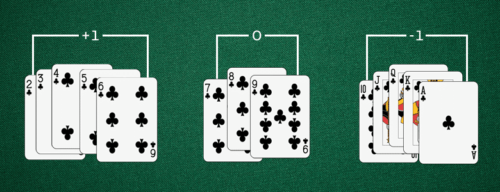The Science of Card Counting
 Card counting is a strategy used in casino card games to give the player an edge over the house. While it is not illegal, many casinos frown upon it and have implemented measures to prevent it. In this article, we will explore the science of card counting, the techniques gamblers use to gain an edge, and how casinos try to prevent it.
Card counting is a strategy used in casino card games to give the player an edge over the house. While it is not illegal, many casinos frown upon it and have implemented measures to prevent it. In this article, we will explore the science of card counting, the techniques gamblers use to gain an edge, and how casinos try to prevent it.
What is Card Counting?
Card counting is a technique used to keep track of the cards dealt in a card game. It is most commonly associated with blackjack but can also be used in games like baccarat and poker. Card counting aims to identify if the remaining cards in the deck are favorable to the player or the house, allowing the player to adjust their betting strategy accordingly.
How Card Counting Works
The basic premise of card counting is that certain cards are more favorable to the player than others. For example, a deck with higher cards (10s and face cards) is more favorable to the player because it increases the chances of getting a blackjack, which pays out at 3 to 2 odds. Conversely, a deck with more low cards (2s through 6s) is more favorable to the house because it decreases the chances of the player getting a blackjack.
Card counters keep track of the ratio of high cards to low cards that have been dealt. This is typically done by assigning a point value to each card. High cards are given a negative value (-1, -2, or -3), and low cards are given a positive value (+1, +2, or +3). When a card is dealt, the player adds or subtracts the point value from a running count. The running count gives the player an idea of whether the deck is in their favor.
The player then uses this information to adjust their betting strategy. When the deck is in their favor, they increase their bets to take advantage of the higher chances of winning. When the deck is not in their favor, they decrease their bets to limit their losses.
Techniques Used by Gamblers
There are several techniques that gamblers use to count cards. The most basic technique is called the hi-lo method. In this method, cards are assigned a point value of +1, 0, or -1. Next, the player keeps a running count of the cards as they are dealt and then divides the running count by the number of decks left in the shoe to get an accurate count.
Another technique used by gamblers is called shuffle tracking. In this technique, the player tries to keep track of certain groups of cards as they are shuffled. This is typically done by watching for patterns in the way the dealer shuffles the cards. The player can then adjust their betting strategy accordingly, increasing their bets when the deck is in their favor and decreasing them when it is not.
Finally, some gamblers use team play to count cards. In team play, several players work together to count cards and signal each other when the deck is in their favor. This allows them to increase their bets and take advantage of the favorable deck.
 Famous Card Counting Incidents or Players
Famous Card Counting Incidents or Players
There have been several famous incidents involving card counting over the years. The MIT blackjack team was a group of MIT students who won millions of dollars by using card counting at casinos worldwide. The team was active from the late 1970s to the early 2000s and was the subject of several books and movies.
Another famous card counter is Don Johnson, a professional gambler who won over $15 million playing blackjack in Atlantic City casinos in 2011. Johnson used a combination of card counting and negotiating favorable rules with the casinos to gain an edge.
Legal Implications of Card Counting
Card counting is not illegal, but casinos do have the right to refuse service to anyone they suspect of using this technique. In addition, in some states, like Nevada, casinos have the legal right to detain and question suspected card counters. However, using electronic devices to aid card counting is illegal in most jurisdictions.
Some people argue that card counting is cheating because it gives the player an unfair advantage over the house. Controversy surrounds card counting in casinos, with some considering it skill-based, while others call it cheating.
Casinos’ Measures to Prevent Card Counting
Many casinos have implemented measures to prevent card counting. One standard method is to use multiple decks of cards in blackjack. This makes it harder for players to keep track of the cards that have been dealt. Another method is automatic shuffling machines that constantly shuffle the cards after each hand. This prevents players from being able to track specific groups of cards through the shuffle.
Casinos may employ countermeasures to prevent card counting, such as banning suspected players, using facial recognition, and changing game rules.
Effectiveness of Measures to Prevent Card Counting
While these measures may make it harder for card counters to succeed, they could be more foolproof. Skilled card counters can still find ways to gain an edge, even with multiple decks and automatic shuffling machines. Changing the game’s rules may deter some players, but it may also make it less appealing to casual players not using this technique.
Conclusion
Card counting is a technique skilled gamblers use to gain an edge over the house in casino card games like blackjack, baccarat, and poker. It involves keeping track of the cards dealt with and adjusting the betting strategy accordingly. While this is not illegal, casinos have taken measures to prevent it, such as using multiple decks and automatic shuffling machines. Facial recognition technology is also used to identify known card counters and prevent them from playing. However, these measures could be better, and skilled card counters can still find ways to gain an edge. Card counting’s ethical status is disputed, but it requires a combination of skill, practice, and luck to be successful.
